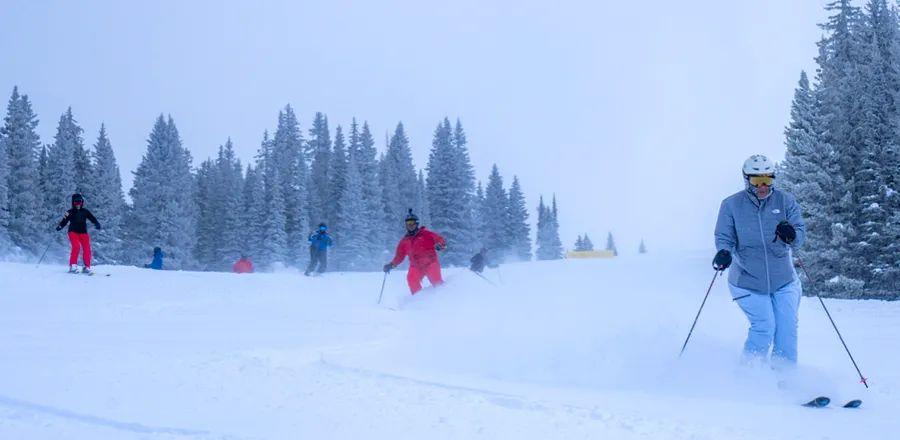Making Ski Slopes More Inclusive

Growing up, Annette Diggs had never seen anyone ski in her Memphis neighborhood. It wasn't until she was bussed to a predominantly white school district for a program aimed at improving integration that she discovered the world of snow sports. With her family unable to afford lessons, she promised herself that one day, she would embrace the great outdoors.
Years later, after relocating to Seattle, she fulfilled that promise by enrolling in ski lessons. However, she quickly felt out of place, as if all eyes were on her.
"I recall getting a drink at the café and overhearing someone remark, ‘Look, a unicorn,’” Diggs shared. “I turned around and realized they were referring to me. I was the only one like me in the room, and I didn’t like that feeling at all. That day, I resolved to bring more women of color to the mountains with me.”
She became a ski instructor and, in 2019, established Edge Outdoors, an organization focused on providing women of color with access to snow sports through scholarships for lessons, lift tickets, and gear. Through her efforts, she joined a growing movement of organizations dedicated to dismantling barriers and fostering community for women, BIPOC individuals, and those with disabilities who want to engage in snow sports.
Diversity has long been an issue in snow sports. According to the National Ski Areas Association, a staggering 88.7 percent of skiers and snowboarders in the U.S. are white, with 63 percent being male. Additionally, the industry tends to favor those without disabilities.
One of the longest-standing advocates for increased diversity in snow sports is the National Brotherhood of Snowsports (previously known as the National Brotherhood of Skiers).
Recently, NBS commemorated its 50th annual gathering, where over 2,000 Black skiers and snowboarders gathered for a week in Vail, Colorado. Overall, NBS consists of approximately 5,000 skiers and snowboarders and 57 affiliated snow sports clubs nationwide. As Henri Rivers, CEO of NBS, noted, these clubs attract new members by actively mentoring beginners.
“When a new skier joins us, we support them, help them find equipment, and ensure they take a lesson,” Rivers stated. “The first experience can be daunting. If newcomers are not properly guided and have a negative experience initially, they may never return. We aim to prevent that.”
The strategy appears effective. While only 7 percent of new skiers and snowboarders nationally continue in the sport, that retention rate rises to over 60 percent for NBS members, according to Rivers. This success is notable within a demographic that comprises just 1.5 percent of all skiers and snowboarders.
According to Diggs, the key difference lies in the sense of belonging.
“It’s not solely about providing opportunities to engage in snow sports; it’s also about fostering a space where they can be their true selves,” Diggs explained. “That’s what really enhances retention.”
Diggs emphasized that having instructors from the same backgrounds as newcomers showcases what is achievable.
“Our students learn from individuals who share their appearance and speak their language,” Diggs stated. “We cultivate an atmosphere that feels familiar to them in an otherwise strange setting. This creates a level of vulnerability where people are comfortable making mistakes and celebrating them with joy.”
This is also why both Edge Outdoors and NBS implement athlete-development programs to assist athletes of color in obtaining training for professional or Olympic competition. Such visible role models could motivate others to explore snow sports.
Rivers emphasizes that accessibility is crucial for enhancing diversity in snow sports. Entering the world of skiing or snowboarding often demands an investment of several hundred to thousands of dollars, factoring in lessons, rentals, cold-weather apparel, meals on the slopes, and lift tickets, which can range from $100 to $250 daily. Additionally, there are travel costs for individuals living far from ski resorts.
“The industry must broaden its perspective and recognize that it’s not merely about maximizing profits from first-time skiers,” Rivers stated. “If we could find ways to lower expenses, we would undoubtedly witness an increase in participation from communities of color and other underrepresented groups.”
Some ski resorts have teamed up with nonprofits to make mountain access more affordable, particularly for children who might not otherwise get the opportunity to participate. For example, Vail Resorts, which oversees ski areas like Vail, Breckenridge, and Heavenly Mountain, initiated the Epic for Everyone youth access program aimed at children living in major urban areas near their resorts; this program offers five free lessons, equipment rentals, meals, insights into ski-related careers, and two complimentary lift tickets. In the 2022/2023 season, it engaged with 9,000 children.
“The future of our sport lies in inclusion,” stated Kirsten Lynch, CEO of Vail Resorts. “We hold a significant responsibility to eliminate barriers and ignite a passion for our sport.”
Roy Tuscany founded the High Fives Foundation, which supports individuals who have experienced life-altering injuries, including spinal cord injuries, traumatic brain injuries, and limb loss, by leveraging adventure to reintegrate them into the community.
“Ongoing access is essential for cultivating long-term achievement and a lifelong passion for the sport,” Tuscany remarked.
Each athlete—HFF prefers this term over grantee or awardee because it provides individuals with an identity beyond their injuries and encourages their progress—receives grants designed to elevate them from adaptive skiing or snowboarding beginners to experts. These grants can be utilized for lessons, lift tickets, and specialized adaptive equipment that enables them to keep participating in their chosen snow sport.
“To me, true success is empowering someone to pursue their passion independently and feel at ease doing so,” Tuscany stated.
Evaluation :
5/5



